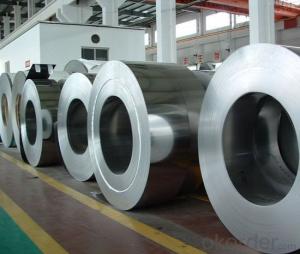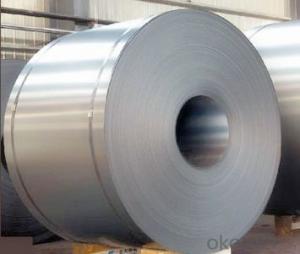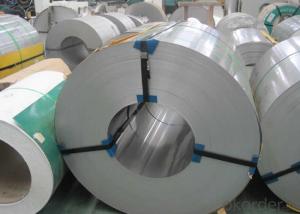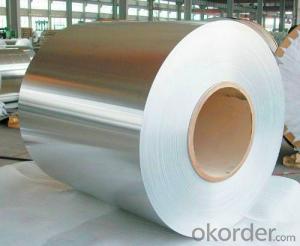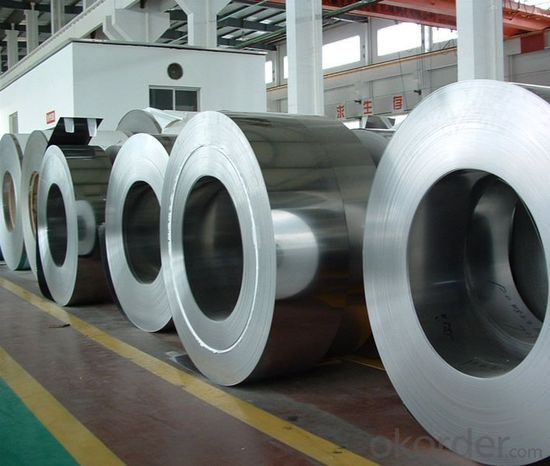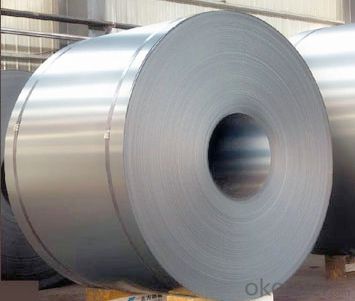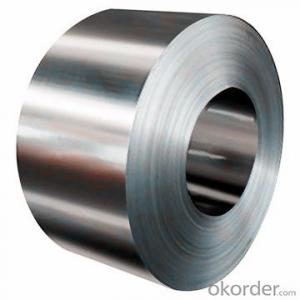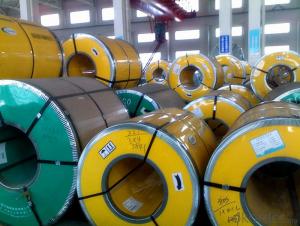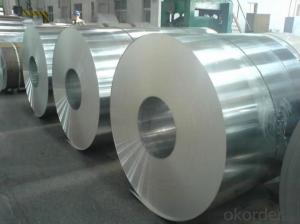Hot / Cold Rolled Stainless Steel Coil 201
- Loading Port:
- Lianyungang
- Payment Terms:
- TT OR LC
- Min Order Qty:
- 100 m.t.
- Supply Capability:
- 5000 m.t./month
OKorder Service Pledge
OKorder Financial Service
You Might Also Like
Hot Rolled Stainless Steel Coil 201 Narrow Strip No.1 Finish
Hot Rolled Stainless Steel 201 half copper Chemical Composition(%) | |||||||
C | Si | Mn | P | S | Ni | Cr | Cu |
0.1 | 0.5 | 10 | 0.04 | 0.01 | 1.20/1.30 | 13.00/14.00 | 0.8/1.0 |
Grade: | 200 Series | Standard: | JIS,AISI,ASTM,GB,DIN | Thickness: | 2.5/3.0/4.0mm |
Width: | 485/510/550/610/1010/1240mm | Place of Origin: | Shanghai China (Mainland) | Brand Name: | CNBM |
Model Number: | 201 | Technique: | Hot Rolled | Application: | Industrial tubes/kitchen/bath |
Certification: | ISO | THK: | 2.5/3.0/4.0mm | Face: | No.1 |
Usage: | tubes/kitchen/bath | Origin: | CHINA | ||
Packaging Detail: For customer's requirement
Delivery Detail: 10-30days
201 Hot Rolled Stainless Steel Coil Specifications
THK:2.3/2.5/3.0/4.0mm
Width:485/510/550/610/1010/1240mm
Face:No.1
201 Hot rolled stainless steel Coil Application
Stainless steel is a production which not easy rust,acid resistance and corrosion resistance,so it is widely
used in light industry,heavy industry,daily necessities and the decoration industry.
201 hot rolled stainless steel coil, use to produce cold rolled stainless steel coil and stainless steel tube, pipe.
201 Hot Stainless Steel Coil Chemical Composition(WT%)
(C):≤0.15, (Si):≤0.75, (Mn):5.5~7.50, (Cr):16.0~18.0, (N):≤0.25, (Ni):3.50~5.50, (P):≤0.060, (S):≤0.030
201 Hot Rolled Stainless Steel Coil
Strength Of Extension:100,000 To 180,000 Psi;
Yield Strength:50,000 To 150,000 Psi
Elongation :55 To 60%;
Modulus Of Elasticity:29,000,000 Psi;
Density :.280lbs/Cubic Inch(7.93g/Cm3)
- Q: What are the different types of finishes for stainless steel strips?
- There are several different types of finishes for stainless steel strips, including brushed, mirror, satin, and embossed finishes.
- Q: What is the typical lead time for stainless steel strip production?
- The lead time for stainless steel strip production can vary depending on different factors. These factors include the complexity of the order, the quantity needed, and the current market conditions. In general, lead times can range from a few weeks to several months. For standard production of stainless steel strip, where the specifications and quantity needed are normal, the lead time is usually shorter. In these cases, it typically takes around 4-8 weeks to complete the production process. This includes sourcing materials, processing, and quality control. However, for customized or specialty production of stainless steel strip, which involves specific dimensions, finishes, or unique requirements, the lead time can be longer. This may require additional time for design consultations, tooling development, and testing. As a result, the lead times can be 2-6 months or even longer. External factors such as supply and demand, availability of raw materials, and production capacities can also affect lead times. When there is high demand or disruptions in the supply chain, lead times may increase due to higher order volumes and potential delays in material sourcing. To get an accurate estimate of the lead time based on your specific requirements, it is important to communicate with the stainless steel strip manufacturer or supplier. They will consider various factors and provide you with a more precise timeline for production and delivery.
- Q: How do stainless steel strips perform in cryogenic environments?
- Stainless steel strips perform well in cryogenic environments as they exhibit excellent resistance to low temperatures, maintaining their strength, toughness, and corrosion resistance.
- Q: How do stainless steel strips perform in the presence of sulfuric acid?
- Stainless steel strips generally exhibit good resistance to sulfuric acid under certain conditions. The performance of stainless steel in the presence of sulfuric acid depends on several factors including the concentration and temperature of the acid, the grade of stainless steel, and the duration of exposure. In general, stainless steel is resistant to dilute sulfuric acid solutions (up to 10%) at room temperature. The passive film that naturally forms on the surface of stainless steel provides excellent protection against corrosion in these conditions. The resistance can vary depending on the specific grade of stainless steel, with austenitic stainless steel (such as 304 and 316) offering better corrosion resistance than ferritic or martensitic grades. However, as the concentration of sulfuric acid increases or the temperature rises, the corrosion resistance of stainless steel can be compromised. At higher concentrations (above 10%) or elevated temperatures, stainless steel may experience localized corrosion, including pitting or crevice corrosion. Under such conditions, it is common to use higher alloyed stainless steels, such as duplex or super duplex grades, which offer enhanced resistance to sulfuric acid. It is important to note that prolonged exposure to sulfuric acid can eventually lead to corrosion even in stainless steel. Therefore, it is advisable to limit the exposure time and concentration of the acid to minimize the risk of corrosion. Additionally, proper maintenance and regular cleaning can help maintain the corrosion resistance of stainless steel in the presence of sulfuric acid.
- Q: How do stainless steel strips perform in the presence of ammonia?
- Ammonia is generally well tolerated by stainless steel strips, which are widely recognized for their outstanding resistance to corrosion. This resistance is particularly evident when it comes to ammonia and its compounds, thanks to the high chromium content present in stainless steel. This chromium forms a protective layer on the surface, effectively shielding the metal from any reactions with ammonia. Moreover, stainless steel's non-porous nature further enhances its ability to repel ammonia and reduce the likelihood of corrosion. Nevertheless, it is worth noting that the performance of stainless steel strips in the presence of ammonia can be influenced by various factors, including the concentration and temperature of the ammonia solution, as well as the specific grade and surface finish of the stainless steel. Consequently, it is advisable to seek guidance from stainless steel manufacturers or corrosion experts when using stainless steel strips with ammonia. This way, the most suitable material selection and maintenance practices can be ensured for specific applications involving stainless steel strips and ammonia.
- Q: Can stainless steel strips be bent or shaped?
- Yes, stainless steel strips can be bent or shaped. Stainless steel is a highly malleable material, meaning it can be easily manipulated into various forms and shapes. With the proper tools and techniques, stainless steel strips can be bent, curved, or formed into a desired shape. The bending or shaping process typically involves using specialized machines such as press brakes, rollers, or mandrels, which apply force to the stainless steel strip to achieve the desired shape. Additionally, the thickness and tempering of the stainless steel strip can also affect its bendability and shapeability. Overall, stainless steel strips offer a great amount of flexibility and can be easily manipulated to fit various applications and designs.
- Q: Are stainless steel strips suitable for automotive body panels?
- Yes, stainless steel strips are suitable for automotive body panels. Stainless steel has excellent corrosion resistance, durability, and aesthetic appeal, making it a popular choice for various automotive applications. It provides strength and can withstand harsh environmental conditions, ensuring the longevity and appearance of the vehicle's body panels.
- Q: Are stainless steel strips easy to clean and maintain?
- Yes, stainless steel strips are easy to clean and maintain. They have a smooth surface that is resistant to stains and corrosion, making them quick to wipe clean. Additionally, they require minimal maintenance and can retain their appearance for a long time with regular cleaning.
- Q: How do stainless steel strips resist crevice corrosion in seawater?
- The unique chemical composition and passive protective layer of stainless steel strips make them resistant to crevice corrosion in seawater. Stainless steel primarily consists of iron, chromium, and other alloying elements like nickel and molybdenum. The presence of high chromium content, typically above 10.5%, is crucial in preventing crevice corrosion. When stainless steel strips come into contact with seawater, the chromium in the alloy reacts with oxygen to create a thin, transparent oxide layer on the surface, known as the passive layer. This passive layer is highly resistant to corrosion, including crevice corrosion. It acts as a protective barrier between the metal and the corrosive environment, preventing the initiation and spread of corrosion in crevices or tight spaces. The passive layer has the ability to self-heal. If it is damaged or removed, it can quickly reform in the presence of oxygen. This characteristic ensures long-term protection against crevice corrosion in seawater, even in challenging marine environments where the metal is constantly exposed to chloride ions and other aggressive elements. Moreover, the addition of alloying elements such as nickel and molybdenum further enhances the corrosion resistance of stainless steel strips. Nickel improves the stability and durability of the passive layer, while molybdenum enhances the alloy's ability to resist pitting and crevice corrosion in chloride-rich environments like seawater. In conclusion, the resistance of stainless steel strips to crevice corrosion in seawater is due to the formation of a protective passive layer on their surface. The high chromium content, along with other alloying elements, enhances the corrosion resistance and durability of the material, making it an excellent choice for various marine applications.
- Q: Can stainless steel strips be used in the pharmaceutical industry?
- Yes, stainless steel strips can be used in the pharmaceutical industry. Stainless steel is a popular material choice due to its high corrosion resistance, durability, and ability to withstand high temperatures and harsh chemicals. It is commonly used for manufacturing pharmaceutical equipment, storage tanks, and process piping to maintain hygienic conditions and prevent contamination in pharmaceutical processes.
Send your message to us
Hot / Cold Rolled Stainless Steel Coil 201
- Loading Port:
- Lianyungang
- Payment Terms:
- TT OR LC
- Min Order Qty:
- 100 m.t.
- Supply Capability:
- 5000 m.t./month
OKorder Service Pledge
OKorder Financial Service
Similar products
Hot products
Hot Searches
Related keywords
